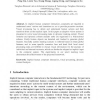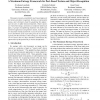403 search results - page 48 / 81 » Adaptive appearance learning for visual object tracking |
CVPR
2005
IEEE
14 years 1 months ago
2005
IEEE
The paper proposes a method to keep the tracker robust to background clutters by online selecting discriminative features from a large feature space. Furthermore, the feature sele...
HCI
2007
13 years 9 months ago
2007
In implicit human computer interaction, computers are required to understand users’ actions and intentions so as to provide proactive services. Visual processing has to detect an...
CVPR
1998
IEEE
14 years 9 months ago
1998
IEEE
We describe a vision system that monitors activity in a site over extended periods of time. The system uses a distributed set of sensors to cover the site, and an adaptive tracker...
ICCV
2005
IEEE
14 years 9 months ago
2005
IEEE
This paper presents a probabilistic part-based approach for texture and object recognition. Textures are represented using a part dictionary found by quantizing the appearance of ...
CORR
2010
Springer
13 years 7 months ago
2010
Springer
Adaptive sparse coding methods learn a possibly overcomplete set of basis functions, such that natural image patches can be reconstructed by linearly combining a small subset of t...



